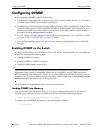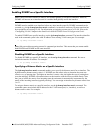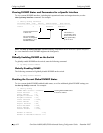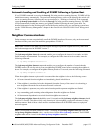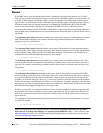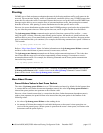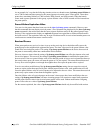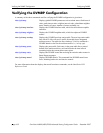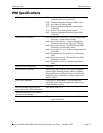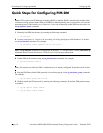
Configuring DVMRP Configuring DVMRP
OmniSwitch 6800/6850/9000 Advanced Routing Configuration Guide December 2007 page 6-17
Grafting
A pruned branch will be automatically reattached to the multicast delivery tree when the prune times out.
However, the graft mechanism provides a quicker method to reattach a pruned branch than waiting for the
prune to time out. As traffic is forwarded, routers that do not want multicast traffic send Prune messages to
signal the upstream router to stop sending the traffic. If new IGMP membership requests are later received
by the downstream router, the router can send Graft messages to the upstream router and wait for
acknowledgment (a Graft Ack).
The ip dvmrp graft-timeout command enables you to set the Graft message retransmission value. This
value defines the duration of time that the router will wait before retransmitting a Graft message if it has
not received a Graft-Ack message acknowledging that a previously transmitted Graft message was
received. For example, enter the following to set the Graft message retransmission value to 5 seconds:
-> ip dvmrp graft-timeout 5
Note. Current global DVMRP parameter values, including the ip dvmrp graft-timeout value, can be
viewed via the show ip dvmrp command.
Tunnels
DVMRP networks may use DVMRP tunnels to interconnect two multicast-enabled networks across non-
multicast networks. In a DVMRP tunnel, IP multicast packets are encapsulated in unicast IP packets so
that the multicast traffic can traverse a non-multicast network.
The ip dvmrp tunnel command enables you to add or delete a DVMRP tunnel between a specified local
interface name and remote address. Any packets sent through the tunnel will be encapsulated in an outer
IP header. For example, the following command would create a tunnel between local name vlan-2 and
remote address 172.22.2.120:
-> ip dvmrp tunnel vlan-2 172.22.2.120
The local tunnel address must match an existing IP interface on a router that has been configured for
DVMRP. The tunnel’s remote address must be the IP address of the remote DVMRP router to which the
tunnel is connected.
Important. The tunnel will be operational only when the DVMRP interface is also operational. To enable
DVMRP on an interface, use the ip dvmrp interface. For more information, refer to “Enabling DVMRP
on a Specific Interface” on page 6-11.
The ip dvmrp tunnel ttl command sets the tunnel’s Time-To-Live (TTL) value. For example:
-> ip dvmrp tunnel vlan-2 172.22.2.120 ttl 255
Note. Current DVMRP tunnels, including the tunnels’ operational (OPER) status and TTL values, can be
viewed via the show ip dvmrp tunnel command. The status of the DVMRP interface can be viewed via
the show ip dvmrp interface command.




